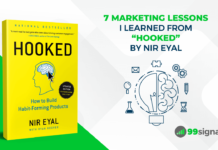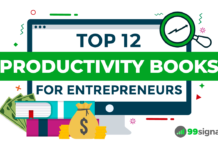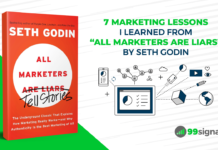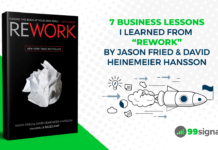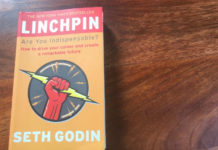
In their brilliant book Traction, authors Gabriel Weinberg and Justin Mares reveal nineteen different traction channels and offer a three-step framework, called the Bullseye framework, to figure out which traction channel works best for your business.
Of all the business books I’ve read over the years, Traction is one of those books that I keep revisiting. It’s also one of the most practical and actionable marketing book ever put to paper.
Before we get to the marketing lessons featured in Traction, it’s important that you know the definition of traction and the different traction channels discussed in the book.
Table of Contents
What is Traction?
Traction is a sign that your company is growing. It can be seen in your core metrics: If you have a mobile app and your download rate is growing, that means your company has achieved traction. In other words, traction is growth.
The book uses this definition of traction by angel investor and serial entrepreneur Naval Ravikant:
Traction is basically quantitative evidence of customer demand.
The pursuit of traction is what defines a startup. In their research, Weinberg and Mares discovered nineteen different customer acquisition channels, aka traction channels. These are marketing and distribution channels through which your startup can achieve real customer growth.
Here are the 19 different traction channels that the book deep dives into:
- Targeting Blogs
- Publicity
- Unconventional PR
- Search Engine Marketing (SEM)
- Social and Display Ads
- Offline Ads
- Search Engine Optimization (SEO)
- Content Marketing
- Email Marketing
- Engineering as Marketing
- Viral Marketing
- Business Development
- Sales
- Affiliate Programs
- Existing Platforms
- Trade Shows
- Offline Events
- Speaking Engagements
- Community Building
This book explains in length with examples and case studies how each of these traction channels can work for your business and how you can use the Bullseye framework to zero in on a traction channel that works best for you.
For me, the two channels that resonated the most were SEO and content marketing, because quite frankly, these are the two channels that have worked best for me and for my clients. As such, the last two marketing lessons featured here are from the SEO and content marketing chapters of the book.
But if you’re a small business owner, I’d encourage you to experiment with all of these channels to figure out which is the one best traction channel you can use to grow your business.
As I share before every article in my “Book Lessons” series, I’d be doing a disservice to the book if I were to summarize its content in this compressed blog post. Please treat these lessons below as a book summary of Traction or my key takeaways from the book. I’d urge you to pick up a copy of Traction to get a better understanding of all the nineteen traction channels featured in the book and the best way to implement the three-step Bullseye framework for your business.
With that said, here are the 7 marketing lessons I learned from Traction by Gabriel Weinberg and Justin Mares.
7 Marketing Lessons from Traction by Gabriel Weinberg and Justin Mares
1. The 50 Percent Rule
“The 50 percent rule: Spend 50 percent of your time on product and 50 percent on traction.”
Having a great product or service is only job half done. If you don’t have a good distribution strategy, you’ll not be able to acquire new customers. As Peter Thiel, venture capitalist and author of Zero to One puts it, “Poor distribution — not product — is the number one cause of failure.”
To solve this common problem that many startups face, Weinberg and Mares suggest that you spend your time building your product or service and testing traction channels in parallel. This is called the 50 percent rule.
This rule may seem simple, but it’s not easy to follow. This is because the temptation to focus solely on product is strong. For many entrepreneurs, a lot of traction activities fall outside their comfort zone. Furthermore, running traction tests in parallel can slow down product development; and building great products is probably one of the main reasons why most founders pursued entrepreneurship in the first place.
But the truth is, the 50 percent rule can speed up the process of launching your product successfully to market. This may sound counterintuitive, but it’s true. A key benefit to parallel product and traction development is that you can build the right product by incorporating good feedback from early customers.
By interacting with your early customers, you can find out how the market is responding to your product and what features are missing from your product. The 50 percent rule ensures that you’re not spending time on the wrong things in terms of product development.
Bottom line: If you follow the 50 percent rule right from the beginning, then you’ll have the best chance to avoid the traps that doomed startups fall into. This rule will guide you around these traps and toward the traction channel that’s best suited for your business.
2. The Bullseye Framework
“Bullseye is designed to be a straightforward way to direct your traction focus and maximize your results.”
With nineteen different traction channels, it’s not easy to focus on just one. To make things easier for entrepreneurs, Weinberg and Mares recommend the three-step Bullseye framework. They named their framework Bullseye because you’re aiming for the Bullseye — the one traction channel at the center of the target that will unlock your next growth stage.
Let’s examine the three steps involved in the Bullseye framework:
I. The Outer Ring
The first step is to brainstorm every single traction channel. For each channel, you should identify one channel strategy that has a chance of providing the best results. For instance, if social ads is the traction channel, then running ads on Facebook is a channel strategy.
II. The Middle Ring
The second step is running cheap traction tests in the channels that seem most promising. You need to review the channels in the outer ring and move the best channels to the middle ring. Make sure you have more than one traction channel in your middle ring.
For each traction channel in the middle ring, design a cheap traction test to determine how good or bad the idea is. These tests should answer the following questions:
- How much will it cost to acquire customers through this channel?
- How many customers are available through this channel?
- Are the customers you’re getting through the channel the customers you want right now?
An important thing to remember while running traction tests is that you’re not trying to get a lot of traction with a channel just yet. Your main consideration at this point is speed — to get data and to prove your assumptions.
Make sure the traction tests you’re running here are cheap and short. For example, don’t start with ten Google ad campaigns. Start with just one or two.
III. The Inner Ring
The final step is to focus solely on one channel that will move the needle for your startup. This is where you finally hit the bullseye!
Once you’ve completed your middle ring tests, you need to pick one traction channel that produced the most promising results.
When you’ve finally completed the three steps in Bullseye, you’ll have identified one channel where you can direct all your traction efforts and resources. This will be your core traction channel.
This is the Bullseye framework in a nutshell. We’ll explore the nuances of traction tests shortly.
3. Defining Your Traction Goal
“Startup growth happens in spurts. Initially, growth is usually slow. Then it spikes as a useful traction channel strategy is unlocked.”
From the perspective of getting traction, you need to think about working on your product in three phases:
Phase 1 — making something people want (product focused)
Phase 2 — marketing something people want (marketing focused)
Phase 3 — scaling your business (business focused)
The authors use the leaky bucket metaphor to describe phase 1. This is the stage when your bucket (product) has the most leaks. At this point, there’s no point in scaling up your efforts, but it’s important to acquire a few customers to see where the holes are and determine the best ways to fix them.
In phase 2, you have product-market fit and customers are sticking around. Now is the time to scale to scale up your traction efforts and fine-tune your positioning and marketing messages.
In phase 3, you have an established business model and significant position in the market, and are focused on scaling both to further dominate the market and to profit.
Moving the needle means different things in each phase. In phase 1, it’s getting those first customers so you know product can get traction. In phase 2, it’s getting enough customers to know you’re on the path to sustainability. In phase 3, you’ll focus on revenue growth, scaling your marketing channels, and creating a sustainable business.
To show readers how traction thinking works, Weinberg provides the example of his own search engine company DuckDuckGo.
- In phase 1, DuckDuckGo’s traction goal was to get in front of users searching for “new search engine.”
- In phase 2, DuckDuckGo had a traction goal of 100 million searches a month.
- In phase 3 (its current phase), DuckDuckGo’s traction goal is to get 1 percent of the general search market.
4. Defining Your Critical Path
“Assess every activity you do against your Critical Path and consistently reassess it.”
Once you’ve defined your traction goal, the next step is to define your Critical Path. The path to reaching your traction goal with the fewest number of steps is your Critical Path. These steps are basically milestones that are absolutely necessary to reach your traction goal.
Taking DuckDuckGo’s traction goal of 100 million searches as an example, the DuckDuckGo team believed the milestones they needed to hit included a faster website, a more compelling mobile offering, and more broadcast TV coverage.
Your milestones will be highly dependent on your business. You need to be critical and strategic in deciding what you need to include in your milestones. Which is why it’s called the Critical Path.
But more importantly, your Critical Path should also help you decide what not to do. All the things you do to reach your traction goal should be assessed against your Critical Path. If adding a specific feature or engaging in a particular marketing activity derails you off your Critical Path, you shouldn’t do it.
Weinberg and Mares believe this is where most entrepreneurs mess up: by focusing their limited resources on things off Critical Path. In all likelihood, you may be competing with companies with significantly more resources than you. As such, you can’t afford to waste what little resources you have.
Bottom line: Determine your traction goal and define your Critical Path against that goal. Then work backward and list down the necessary milestones you need to achieve to reach your traction goal.
5. Running the Traction Tests
“Continuous testing is the key to getting traction with Bullseye.”
As mentioned earlier, the goal of middle ring tests is to find a promising channel strategy that you can focus on to grow your business.
A channel strategy is a way to acquire customers within a traction channel. For instance, if social media ads is a traction channel, then Facebook ads, Twitter ads, and Pinterest ads are all channel strategies within social media ads.
When you’re just starting out testing a traction channel, Weinberg and Mares recommend that you focus on one channel strategy. It’s important to keep the tests cheap and short at this stage. In other words, don’t get deep into tactics; stick to the strategy level.
In particular, your traction tests should be designed to answer three questions:
- How much does it cost to acquire each customer through this channel strategy?
- How many channels are available through this channel strategy?
- Are the customers you are getting through this channel the ones you want right now?
In phase 1 of your middle ring tests, you shouldn’t be spending more than $1000 and a month’s time on a middle ring test. In the next two phases, your channel tests may be longer and bigger in order to meet your traction goal.
The middle ring tests provide you with the data you need to compare channel strategies. If all goes well, you can move on to inner ring testing.
Inner ring tests have a dual role: the first is to optimize your chosen channel strategy. The second role is to uncover better channel strategies within your chosen traction channel.
When it comes to optimization, each channel strategy has a set of things that you can tweak. For example, if search engine marketing (SEM) is your chosen channel strategy, then you can tweak your target keywords, ad copy, demographics, and landing pages.
You should continuously test your chosen channel strategy to increase its effectiveness. The most common approach is to use some form of A/B testing.
By making A/B testing a habit, you’ll improve your efficiency in a traction channel by two or three times.
6. SEO for Startups
“SEO allows you to amplify all of the good things you’re already doing in other traction channels (publicity, unconventional PR, content marketing) and use them to bring in more customers from search engines.”
SEO keyword research involves two high-level strategies: fat-head strategy and long-tail strategy.
Fat-head keywords are one and two-word popular searches that get the highest search volume. Examples of fat-head keywords include phrases like “Amazon”, “Twitter”, and “Reddit.”
Fat-head keywords make up about 30% of all searches. The remaining 70% are long-tail keywords that don’t have a high search volume, but in the aggregate add up to the majority of the searches made.
As you may have guessed, long-tail keywords are easier to rank for than fat-head keywords, provided you create top-notch content.
A fat-head keyword strategy involves trying to rank for keywords that directly describe your company. For example, if you run an online furniture store, then you’d want to rank for fat-head keywords like “fabric sofa” or “leather sofa.”
On the other hand, a long-head keyword strategy involves ranking for keywords like “what is the best fabric for a sofa” or “how to clean fabric sofa at home.” These long-tail keywords may have lower search volumes, but in the aggregate make up to be the majority of all searches.
Which SEO keyword strategy you’ll go for will ultimately depend on your business goals.
To determine whether fat-head strategy is right for your business, you need to first research the keywords people use to find products in your industry, and then see if the search volumes are large enough to move the needle.
Because it’s difficult to rank for competitive fat-head keywords, a long-tail keyword strategy is ideal for early-stage startups to reach a meaningful number of customers.
The authors recommend Google’s Keyword Planner for researching keywords. But my personal recommendation would be to invest in premium SEO tools like Semrush or GrowthBar. You can learn more about these tools by checking out their in-depth reviews below:
Whichever keyword strategy you use, SEO eventually comes down to two things: content and links. While link building is the more challenging of the two, creating amazing content goes a long way in building natural backlinks.
Related: 15 Common SEO Mistakes to Avoid
7. Blogging is the Most Effective Content Marketing Tactic
“The most common hurdle in content marketing is writer’s block. To overcome it, simply write about the problems facing your target customers.”
Blogging is the cornerstone of content marketing. Your business blog can either become a leading source of customer acquisition or it can be an obscure entity that ends up doing more harm than good.
If it does indeed become a lead generation machine, then that means you’ve just unlocked the secrets of a marketing channel that can continue to give you returns in the long run.
To illustrate the power of content marketing, the authors showcase case studies from two vastly different companies: Unbounce (a leading landing page software) and OkCupid (an online dating service).
Both these companies used their blogs to acquire new customers, but did so using completely different approaches. Unbounce started blogging a year before they launched their landing page solution while OkCupid started blogging almost five years after the launch of their dating site.
For both these companies, their blog became their primary source of customer acquisition.
Unbounce founder Rick Perreault started sketching out his product features on his blog. This early adopter approach to blogging allowed Unbounce to build an email list over five thousand strong before product launch.
Here are some key takeaways from Unbounce’s content marketing strategy:
- Unbounce followed a blog-from-the-beginning approach. They also began sketching their product features on the blog. Rick’s first hire was a full-time blogger.
- The Unbounce team relied heavily on social media to drive readers to their blog. After each post, they’d reach out to influencers on Twitter asking for feedback. They also engaged with their target customers on Quora.
- Unbounce captilized on its blog traffic by offering free eBooks and infographics to gain more subscribers.
By the time Unbounce launched their landing page software, their site was getting 20,000 unique visitors a month.
On the other hand, OkCupid’s approach was totally different. They started using blogging as a traction channel five years after their launch.
Here’s how OkCupid’s content marketing worked:
- Unlike Unbounce, the OkCubid team wrote longer posts with less frequency. Each of their blog posts took a month to write and drew on the data they had from studying the usage patters of their members. They also wrote controversial posts to generate traffic and conversation.
- OkCupid never invested in paid advertising. Instead, they focused on traction channels without per-user acquisition costs (content marketing, SEO, viral marketing) to drive its growth.
- OkCupid posts received organic publicity. CNN, Rachael Ray, The New York Times, and many other media outlets were interested in the blog topics they covered.
- Their blog started generating SEO traction by ranking for highly competitive keywords like “online dating” almost a year after their post was published.
One of the many benefits of using content marketing as your core traction channel is how it positions you as an authority in your space. Both Unbounce and OkCupid are great examples of how your blog can make your company a recognized industry leader in a highly competitive space.
Recognition as an industry leader leads to opportunities to speak at major conferences, give press quotes to journalists, and influence industry direction. It also means your content is shared many more times than it would be otherwise.
In the case of Unbounce, being an industry leader brought them comarketing opportunities. When they reached out to companies for integration before their blog gained traction, their business development pitches were ineffective. But once their blog started getting readership, they were able to get numerous integrations (including Salesforce, Mailchimp, and AWeber).
Having a strong company blog can also positively impact at least eight other traction channels — SEO, publicity, email marketing, targeting blogs, community building, offline events, existing platforms, and business development.
Final Thoughts on Traction by Gabriel Weinberg and Justin Mares
The Bullseye framework is a proven method to decide which traction channel is ideal for growing your business. In their book, Gabriel Weinberg and Justin Mares make a compelling case for each of the nineteen traction channels to help you implement the Bullseye framework in the best way possible.
Have you read Traction by Gabriel Weinberg and Justin Mares? What marketing or business lessons were you able to pick from this book? Which of the traction channels resonated the most with you and what results were you able to achieve through them? Please share your thoughts in the comments section below. I’d love to hear from you.
If you liked this article, please share it on Twitter using the link below:
Related Articles
- 7 Marketing Lessons I Learned from “Hooked” by Nir Eyal
- 7 Marketing Lessons I Learned from “All Marketers Are Liars” by Seth Godin
- 85+ Best Books for Entrepreneurs and Business Owners
- 21 Movies Every Entrepreneur Should Watch for Inspiration
- 7 Business Lessons I Learned from “Rework” by Jason Fried & David Heinemeier Hansson




